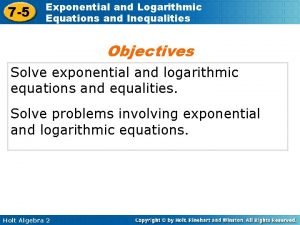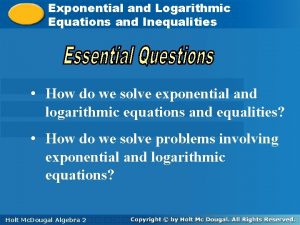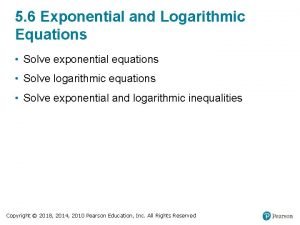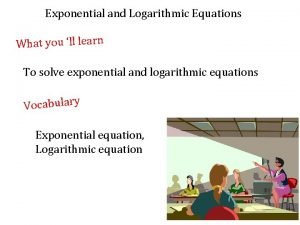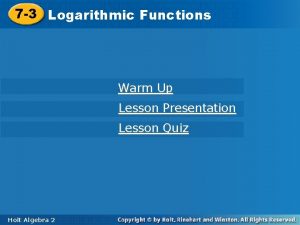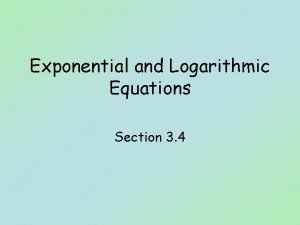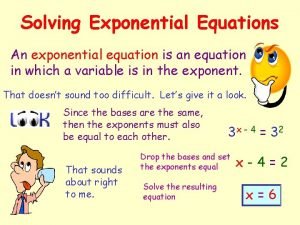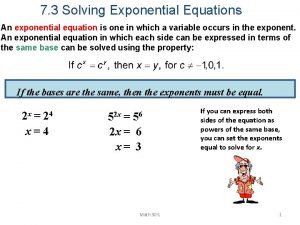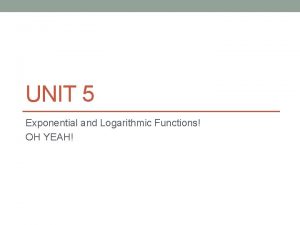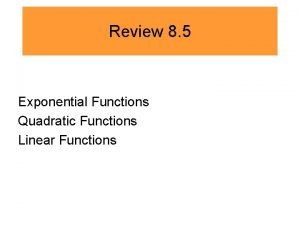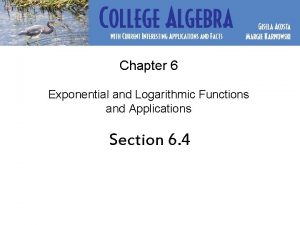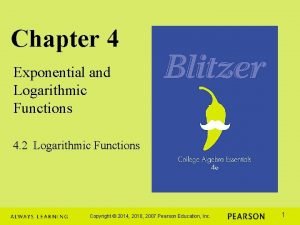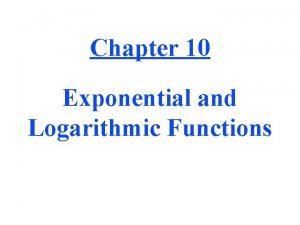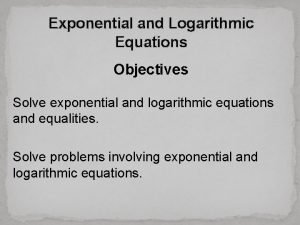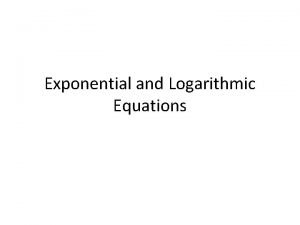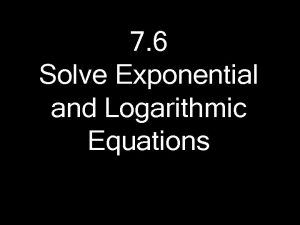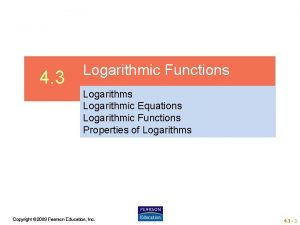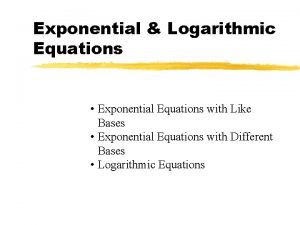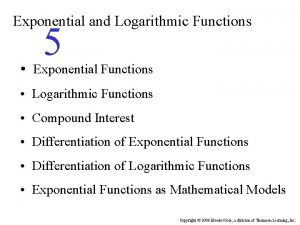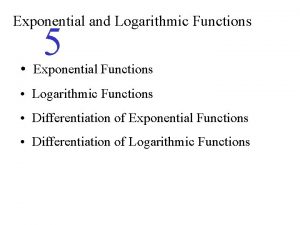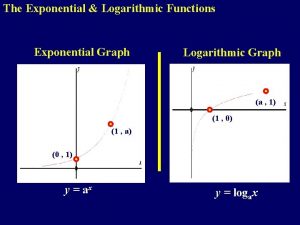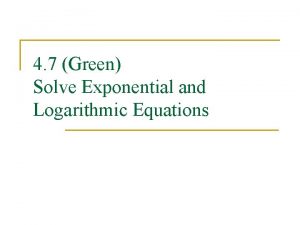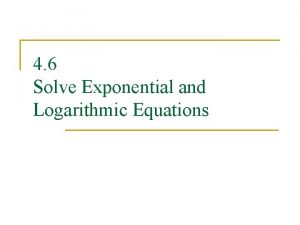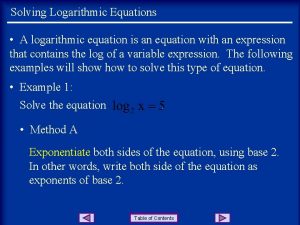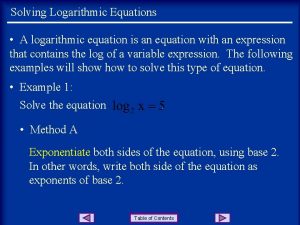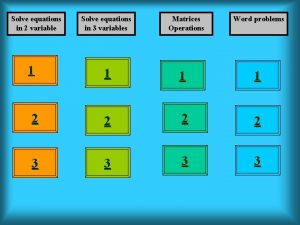5 6 Exponential and Logarithmic Equations Solve exponential



























- Slides: 27

5. 6 Exponential and Logarithmic Equations • Solve exponential equations • Solve logarithmic equations • Solve exponential and logarithmic inequalities Copyright © 2018, 2014, 2010 Pearson Education, Inc. All Rights Reserved

Exponential Equation An equation in which one or more variables occur in the exponent of an expression is called an exponential equation. Copyright © 2018, 2014, 2010 Pearson Education, Inc. All Rights Reserved

Example: Modeling world population (1 of 3) Copyright © 2018, 2014, 2010 Pearson Education, Inc. All Rights Reserved

Example: Modeling world population (2 of 3) Copyright © 2018, 2014, 2010 Pearson Education, Inc. All Rights Reserved

Example: Modeling world population (3 of 3) This model predicts that world population might reach 8 billion during 2024. Copyright © 2018, 2014, 2010 Pearson Education, Inc. All Rights Reserved

Example: Modeling the decline of bluefin tuna (1 of 4) Bluefin tuna are large fish that can weigh 1500 pounds and swim at speeds of 55 miles per hour. Because they are used for sushi, a prime fish can be worth over $50, 000. As a result, the western Atlantic bluefin tuna have had their numbers decline exponentially. (Source: B. Freedman, Environmental Ecology. ) Copyright © 2018, 2014, 2010 Pearson Education, Inc. All Rights Reserved

Example: Modeling the decline of bluefin tuna (2 of 4) a. Estimate the number of bluefin tuna in 1974 and 1991. b. Determine symbolically the year when they numbered 50 thousand. Copyright © 2018, 2014, 2010 Pearson Education, Inc. All Rights Reserved

Example: Modeling the decline of bluefin tuna (3 of 4) Solution a. To determine their numbers in 1974 and 1991, evaluate f(0) and f(17). Bluefin tuna decreased from 230 thousand in 1974 to about 27 thousand in 1991. Copyright © 2018, 2014, 2010 Pearson Education, Inc. All Rights Reserved

Example: Modeling the decline of bluefin tuna (4 of 4) b. Solve the equation f(x) = 50 for x. They numbered about 50 thousand in 1974 + 12. 04 1986. Copyright © 2018, 2014, 2010 Pearson Education, Inc. All Rights Reserved

Example: Solving exponential equations symbolically (1 of 4) Solve each equation. Copyright © 2018, 2014, 2010 Pearson Education, Inc. All Rights Reserved

Example: Solving exponential equations symbolically (2 of 4) Copyright © 2018, 2014, 2010 Pearson Education, Inc. All Rights Reserved

Example: Solving exponential equations symbolically (3 of 4) Copyright © 2018, 2014, 2010 Pearson Education, Inc. All Rights Reserved

Example: Solving exponential equations symbolically (4 of 4) Copyright © 2018, 2014, 2010 Pearson Education, Inc. All Rights Reserved

Example: Solving exponential equations graphically Copyright © 2018, 2014, 2010 Pearson Education, Inc. All Rights Reserved

Logarithmic Equations Logarithmic equations contain logarithms. To solve a logarithmic equation, we use the inverse property Copyright © 2018, 2014, 2010 Pearson Education, Inc. All Rights Reserved

Example: Solving a logarithmic equation Copyright © 2018, 2014, 2010 Pearson Education, Inc. All Rights Reserved

Example: Solving a logarithmic equation symbolically (1 of 5) In developing countries, there is a relationship between the amount of land a person owns and the average daily calories consumed. This relationship is modeled by the formula C(x) = 280 ln(x + 1) + 1925, where x is the amount of land owned in acres and 0 ≤ x ≤ 4. a. Find the average caloric intake for a person who owns no land. Copyright © 2018, 2014, 2010 Pearson Education, Inc. All Rights Reserved

Example: Solving a logarithmic equation symbolically (2 of 5) b. A graph of C is shown. Interpret the graph. c. Determine symbolically the number of acres owned by someone whose average intake is 2000 calories per day. Copyright © 2018, 2014, 2010 Pearson Education, Inc. All Rights Reserved

Example: Solving a logarithmic equation symbolically (3 of 5) Solution a. Since C(0) = 280 ln (0 + 1) + 1925 = 1925, a person without land consumes an average of 1925 calories per day. Copyright © 2018, 2014, 2010 Pearson Education, Inc. All Rights Reserved

Example: Solving a logarithmic equation symbolically (4 of 5) b. The y-intercept of (0, 1925) represents the caloric intake of 1925 calories for a person who owns no land. As the amount of land x increases, the caloric intake y also increases. However, the rate of increase slows. This would be expected because there is a limit to the number of calories an average person would eat, regardless of his or her economic status. Copyright © 2018, 2014, 2010 Pearson Education, Inc. All Rights Reserved

Example: Solving a logarithmic equation symbolically (5 of 5) c. Solve the equation C(x) = 2000. A person who owns about 0. 3 acre has an average intake of 2000 calories per day. Copyright © 2018, 2014, 2010 Pearson Education, Inc. All Rights Reserved

Example: Solving logarithmic equations symbolically (1 of 4) Solve each equation. Copyright © 2018, 2014, 2010 Pearson Education, Inc. All Rights Reserved

Example: Solving logarithmic equations symbolically (2 of 4) Solution Copyright © 2018, 2014, 2010 Pearson Education, Inc. All Rights Reserved

Example: Solving logarithmic equations symbolically (3 of 4) However, − 1 is not a solution since log 2 x in the given equation is undefined. The only solution is 1. Copyright © 2018, 2014, 2010 Pearson Education, Inc. All Rights Reserved

Example: Solving logarithmic equations symbolically (4 of 4) Substituting x = 0 and x = − 4 in the given equation shows that 0 is a solution but − 4 is not a solution. Copyright © 2018, 2014, 2010 Pearson Education, Inc. All Rights Reserved

Exponential and Logarithmic Inequalities If the equality sign in an exponential or logarithmic equation is replaced with <, >, ≤, or ≥ an exponential inequality or logarithmic inequality results. Many times it helps to use our understanding of exponential and logarithmic functions and their graphs to solve these types of inequalities. The fact that equality is often the boundary between greater than and less than is helpful in determining the solution set. Copyright © 2018, 2014, 2010 Pearson Education, Inc. All Rights Reserved

Example: Solving exponential inequalities Solve the inequality. Write the solution set in interval notation. Copyright © 2018, 2014, 2010 Pearson Education, Inc. All Rights Reserved
 7-5 exponential and logarithmic equations and inequalities
7-5 exponential and logarithmic equations and inequalities Solving exponential and logarithmic equations quiz
Solving exponential and logarithmic equations quiz 4-5 exponential and logarithmic equations and inequalities
4-5 exponential and logarithmic equations and inequalities Solving logarithmic equations and inequalities
Solving logarithmic equations and inequalities Exponential and logarithmic equations and inequalities
Exponential and logarithmic equations and inequalities Exponential and logarithmic inequalities
Exponential and logarithmic inequalities Modeling with exponential and logarithmic equations quiz
Modeling with exponential and logarithmic equations quiz Graphing logs and exponentials worksheet
Graphing logs and exponentials worksheet 7-3 lesson quiz
7-3 lesson quiz 3-4 exponential and logarithmic equations
3-4 exponential and logarithmic equations 3-4 exponential and logarithmic equations
3-4 exponential and logarithmic equations Exponentiate both sides
Exponentiate both sides 3-4 exponential and logarithmic equations
3-4 exponential and logarithmic equations Difficult exponential equations
Difficult exponential equations Solve simple equations
Solve simple equations Solving for exponents
Solving for exponents Solving exponential inequality
Solving exponential inequality Unit 8 review logarithms
Unit 8 review logarithms Unit 5 exponential and logarithmic functions answers
Unit 5 exponential and logarithmic functions answers Linear exponential and quadratic functions
Linear exponential and quadratic functions Chapter 6 exponential and logarithmic functions answers
Chapter 6 exponential and logarithmic functions answers Chapter 4 exponential and logarithmic functions
Chapter 4 exponential and logarithmic functions Lesson 10-2 exponential growth and decay
Lesson 10-2 exponential growth and decay Property of equality for exponential functions
Property of equality for exponential functions Exponential and logarithmic models
Exponential and logarithmic models Transforming exponential and logarithmic functions
Transforming exponential and logarithmic functions Reverse exponential graph
Reverse exponential graph Lesson 5-2
Lesson 5-2
